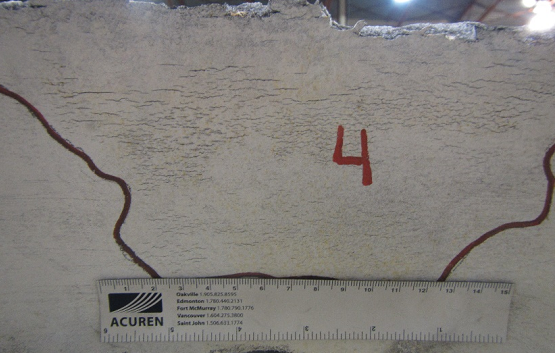In a newly released investigation report,1 the Transportation Safety Board of Canada (TSB) (Gatineau, Quebec, Canada) found that stress corrosion cracking (SCC) led to a pipeline rupture resulting in a fire near Prince George, British Columbia in 2018.
Moreover, deficiencies in predicting the extent of cracking and a deferred inspection led to a hazard being undetected prior to the rupture, according to the report.
The TSB is an independent agency that investigates air, marine, pipeline, and rail transportation occurrences throughout Canada. The board’s sole aim is the advancement of transportation safety, and it does not assign fault or determine civil or criminal liability.
Background of the Incident
On Oct. 9, 2018, a 36-inch (91.4 cm) natural gas pipeline operated by Westcoast Energy Inc. ruptured about 13 km northeast of Prince George. Westcoast is an indirect subsidiary of Enbridge Inc. (Calgary, Alberta, Canada).
Following the rupture, the natural gas being transported within the line was released and ignited, resulting in a fire. There were no injuries; however, 125 people within a 2 km radius of the rupture were evacuated as a precaution.
The investigation found that the pipeline ruptured due to stress corrosion cracks on its outside surface; and that the polyethylene tape coating applied to the exterior surface as a measure to protect the pipeline from corrosion had deteriorated over time. This allowed soil moisture to come into contact with the pipe surface, leading to corrosion and cracking. Growing and merging over time, the cracks reduced the pipeline’s load-bearing capacity at normal operating pressures.
“Built in 1972, its exterior surface was coated with polyethylene tape,” the TSB writes. “The pipeline was further protected from corrosion using an impressed current cathodic protection (CP) system. In response to coating disbondment, the pipeline’s CP system protects the pipeline from corrosion as long as the CP current reaches the pipe surface. Polyethylene tape coatings are prone to disbondment over time due to tenting between the tape coat and the longitudinal weld, or along the tape overlap between successive wraps of tape. When such coatings disbond, they shield the pipe surface from CP current.”
Excessive Crack Growth

The pipeline operator had a SCC hazard management plan in place. However, the extent of the existing cracking on the ruptured pipe segment was not identified, and the model used to predict crack growth did not take into account all potential uncertainties in the predicted crack growth.
“At the time of the occurrence, the model used to calculate crack growth rates was based primarily on the results of previous inspections,” the TSB reports. “It did not consider SCC was below the in-line inspection detection threshold, nor the possibility of an increase in crack size due to crack coalescence.”
This resulted in cracks growing at higher rates than the model predicted. Additionally, an inspection of this pipeline segment scheduled for 2017 was deferred until the fall of 2018. As such, the existing cracks remained undetected.

“Over time, the tape coating on the [failed] segment had started to disbond from the pipe surface,” TSB writes. “Although no free water was observed in the crater, minor water systems in the vicinity of the pipeline right-of-way created a moist environment in the soil. The disbonded coating allowed the moisture in the soil to contact the pipe surface and shield it from the beneficial effects of CP, creating the environment for SCC to initiate.”
“Once initiated, SCC continued to grow over time, assisted by the internal pressure associated with normal pipeline operations,” TSB adds. “Gradually, the SCC reduced the load-bearing capacity of the pipeline steel.”
Safety Advisory Letter
Following the occurrence, the TSB issued a pipeline safety advisory letter to Westcoast Energy regarding the management of SCC of susceptible pipelines. The letter suggested that the operator further review its SCC management practices, including inspection intervals, to mitigate the risks associated with polyethylene tape-coated pipe.

“One of the factors associated with near-neutral pH SCC on pipelines is the use of polyethylene tape coating,” the TSB wrote in its letter. “This type of coating has a tendency to separate from the pipeline, allowing moisture present in the soil to contact the pipe surface while shielding it from the cathodic protection current.”
“Given the presence of SCC-susceptible pipe, Westcoast may wish to review its SCC management practices, including in-line inspection intervals, to ensure that the risks associated with polyethylene tape-coated pipe are mitigated,” TSB concludes.
In response to the letter, the operator revised several aspects of its inspection practices and integrity management program for this pipeline. Subsequently, Canada’s National Energy Board (Calgary, Alberta, Canada) restricted operating pressures until it approved the submitted engineering assessments to ensure safe operation of the relevant pipeline segments. The regulator also conducted field inspections to ensure regulatory requirements were met.
Sources: TSB, www.tsb.gc.ca.
Reference
1 “Stress Corrosion Cracking Led to October 2018 Pipeline Rupture and Fire near Prince George, British Columbia,” Transportation Safety Board of Canada News Releases, March 4, 2020, https://www.tsb.gc.ca/eng/medias-media/communiques/pipeline/2020/p18h0088-20200304.html (March 18, 2020).